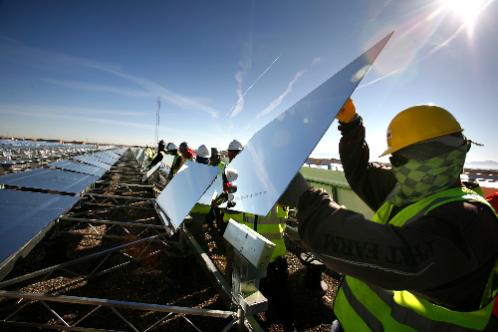What Exactly is a "Green" Job? (Updated)

Here's a skill-testing hypothetical for you environmentalists out there.
Some future US government decides to impose a tax on oil to maintain the price above $125 a barrel.
Responding to this price signal, more Americans tell their real estate agents they want housing from which they can walk to work.
Responding to this market signal, more real estate developers build mixed-use residential-office-shopping developments.
These foot commuters now have more time and cash to pause on the way home from work to share a cappucino with friends.
To serve the extra customers, local cafes hire additional waitstaff.
Question: do the new service hires count as "green jobs"?
---
Here's why my hypothetical question about green jobs is important:
When the Obama administration talks "green jobs," it joins two ideas that really don't belong together at all. It is the forced juncture of these ideas that led to the Solyndra debacle.
Idea 1: We have to move away from fossil fuels, especially oil.
Idea 2: The move away from fossil fuels can generate lots of high-paying manufacturing jobs here in the United States.
Familiarity can add plausibility to even the most unconvincing claims, and so it is with the green jobs story. There is no reason whatsoever to believe Idea 2, and overwhelming reason to disbelieve it.
---
The extraction of energy from oil and coal is almost the paradigmatic industrial activity.
Oil and coal are also almost inescapably domestic industries: coal of course is mined in the US, while oil is refined here. Oil refineries employ 65,000 Americans; the larger industry of transforming oil into gasoline, moving the gasoline, and fueling the gasoline into cars employs some 900,000 Americans. A new refinery employs about 17,000 people. Compare that to the 1,100 combined total - blue collar and white collar - of the entire Solyndra company.
Coal and oil jobs are inherently difficult to off-shore. Manufacturing wind turbines and even solar panels: very different story. They are already being manufactured in China. And to the extent that those manufacturing industries do remain in the US, it will be because they can be organized in ways that rely much more on robot devices than human labor.
The creation of solar panels typically involves cutting crystalline silicon into tiny disks less than a centimeter thick. These thin, wafer-like disks are then carefully polished and treated to repair and gloss any damage from the slicing process. After polishing, dopants (materials added to alter an electrical charge in a semiconductor or photovoltaic solar cell) and metal conductors are spread across each disk. The conductors are aligned in a thin, grid-like matrix on the top of the solar panel, and are spread in a flat, thin sheet on the side facing the earth.
It's clearly true that a transition from oil and coal to new energy sources will generate new employment. But the idea that the employment will take the form of high-wage industrial employment for non-college-graduates is an illusion driven by the coalition imperatives of the Democratic party - not industrial reality.
- MORE TO COME -

